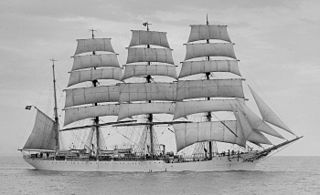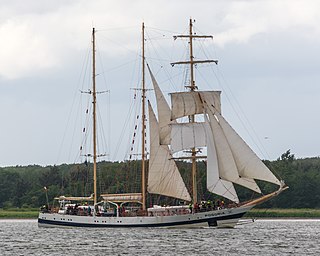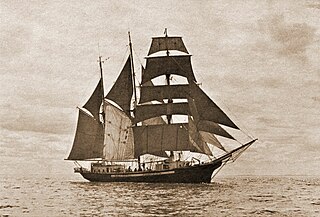
Cutty Sark is a British clipper ship. Built on the River Leven, Dumbarton, Scotland in 1869 for the Jock Willis Shipping Line, she was one of the last tea clippers to be built and one of the fastest, coming at the end of a long period of design development for this type of vessel, which halted as steamships took over their routes.

A brig is a type of sailing vessel defined by its rig: two masts which are both square-rigged. Brigs originated in the second half of the 18th century and were a common type of smaller merchant vessel or warship from then until the latter part of the 19th century. In commercial use, they were gradually replaced by fore-and-aft rigged vessels such as schooners, as owners sought to reduce crew costs by having rigs that could be handled by fewer men. In Royal Navy use, brigs were retained for training use when the battle fleets consisted almost entirely of iron-hulled steamships.

A tall ship is a large, traditionally-rigged sailing vessel. Popular modern tall ship rigs include topsail schooners, brigantines, brigs and barques. "Tall ship" can also be defined more specifically by an organization, such as for a race or festival.

The Dar Pomorza is a Polish full-rigged sailing ship built in 1909 which is preserved in Gdynia as a museum ship. She has served as a sail training ship in Germany, France, and Poland. Dar Pomorza won the Cutty Sark Trophy in 1980.

From its modern interpretations to its antecedents when maritime nations would send young naval officer candidates to sea, sail training provides an unconventional and effective way of building many useful skills on and off the water.

The tall ship Elissa is a three-masted barque. She is based in Galveston, Texas, and is one of the oldest ships sailing today. Launched in 1877, she is now a museum ship at the Texas Seaport Museum. She was designated a National Historic Landmark in 1990.

Alexander von Humboldt is a German sailing ship originally built in 1906 by the German shipyard AG Weser at Bremen as the lightship Reserve Sonderburg. She was operated throughout the North and Baltic Seas until being retired in 1986. Subsequently, she was converted into a three masted barque by the German shipyard Motorwerke Bremerhaven and was re-launched in 1988 as Alexander von Humboldt. In 2011 the ship was taken off sail-training and sent to the Caribbean for the charter business, then she was converted to a botel.

Moshulu is a four-masted steel barque, built as Kurt by William Hamilton and Company at Port Glasgow in Scotland in 1904. The largest remaining original windjammer, she is currently a floating restaurant docked in Penn's Landing, Philadelphia, adjacent to the museum ships USS Olympia and USS Becuna.

STS Sedov, formerly Magdalene Vinnen II (1921–1936) and Kommodore Johnsen (–1948), is a four-masted steel barque that for almost 80 years was the largest traditional sailing ship in operation. Originally built as a German cargo ship, Sedov is today a sail training vessel, training cadets from the universities of Kaliningrad, Saint Petersburg and Astrakhan. She participates regularly in the big maritime international events as a privileged host and has also been a regular participant in The Tall Ships' Races.

Viking is a four-masted steel barque, built in 1906 by Burmeister & Wain in Copenhagen, Denmark. She is reported to be the biggest sailing ship ever built in Scandinavia. In the 21st century her sailing days have drawn to a close, and is now moored as botel in Gothenburg, Sweden.

West Island College (WIC) is a system of three Canadian private schools: West Island College Montreal, founded in 1974, West Island College Calgary, founded in 1982, and Class Afloat–West Island College International, founded in 1984.

Swan fan Makkum is a brigantine, built in 1993 in the Gdansk shipyard, Poland. Named for Willem Sligting, Makkum, christened by Hinke de Vries, co-owner and wife, in a multilingual fashion: English, Polish and Frysian and after the ceremony launched in the river Wisła. She is the largest brigantine in the world, as well as the largest two masted sailing vessel, with an overall length of 61 metres (200 ft).

Herzogin Cecilie was a German-built four-mast barque (windjammer), named after German Crown Princess Duchess Cecilie of Mecklenburg-Schwerin (1886–1954), spouse of Crown Prince Wilhelm of Prussia (1882–1951). She sailed under German, French and Finnish flags.

The Tall Ships Races are races for sail training "tall ships". The races are designed to encourage international friendship and training for young people in the art of sailing. The races are held annually in European waters and consists of two racing legs of several hundred nautical miles, and a "cruise in company" between the legs. Over one half of the crew of each ship participating in the races must consist of young people.

STS Pogoria is a Polish barquentine launched in 1980. She was designed by the naval architect Zygmunt Choreń as the first in a series of middle and large-size contemporary sailing vessels.

Grain Race or The Great Grain Race was the informal name for the annual windjammer sailing season generally from South Australia's grain ports on Spencer Gulf to Lizard Point, Cornwall on the southwesternmost coast of the United Kingdom, or to specific ports. A good, fast passage Australia-to-England via Cape Horn was considered anything under 100 days.

Priwall was a four-masted steel-hulled barque with royal sails over double top and topgallant sails. The windjammer was ordered by the F. Laeisz shipping company of Hamburg and launched at the Blohm & Voss yard, Hamburg, on 23 June 1917. After delays arising from a shortage of materials during and after First World War, she was completed on 6 March 1920. Priwall was used on the nitrate trade route to the west coast of South America; she also made several voyages from South Australia’s Spencer Gulf grain ports to Europe. Her code Letters were RWLN; in 1934 they were changed to DIRQ.

The sailing ship Regina Maris was originally built as the three-masted topsail schooner Regina in 1908. She was a 144-foot (43.9-meter), wooden, completely fore-and-aft–rigged sailing ship with three masts. She was re-rigged in 1963 as a 148-foot (45.1-meter) barquentine. Regina Maris could reach a speed of up to 12 knots, especially on a half-wind course or with a fresh back-stay breeze.

Zebu, formerly Ziba, was a historic tall ship. Built in Sweden in 1938, she was used as a trading vessel until the late 1960s, before circumnavigating the globe in the 1980s. She has been based in Liverpool since the 1980s. She sank in 2015, and was subsequently restored. She partially sank again in 2021 after running aground on Holyhead breakwater after slipping her anchor, and had masts and sails removed to reduce weight so the hull could be moved. On 21 May 2021 after suffering further damage due to a storm, she was declared a wreck.

Indian Trader was launched in 1791. She made one voyage for the British East India Company (EIC). She was on her second voyage when a French privateer captured her. The British recaptured her and she returned to merchant service, sailing to the Americas. She was lost c.1830.




















